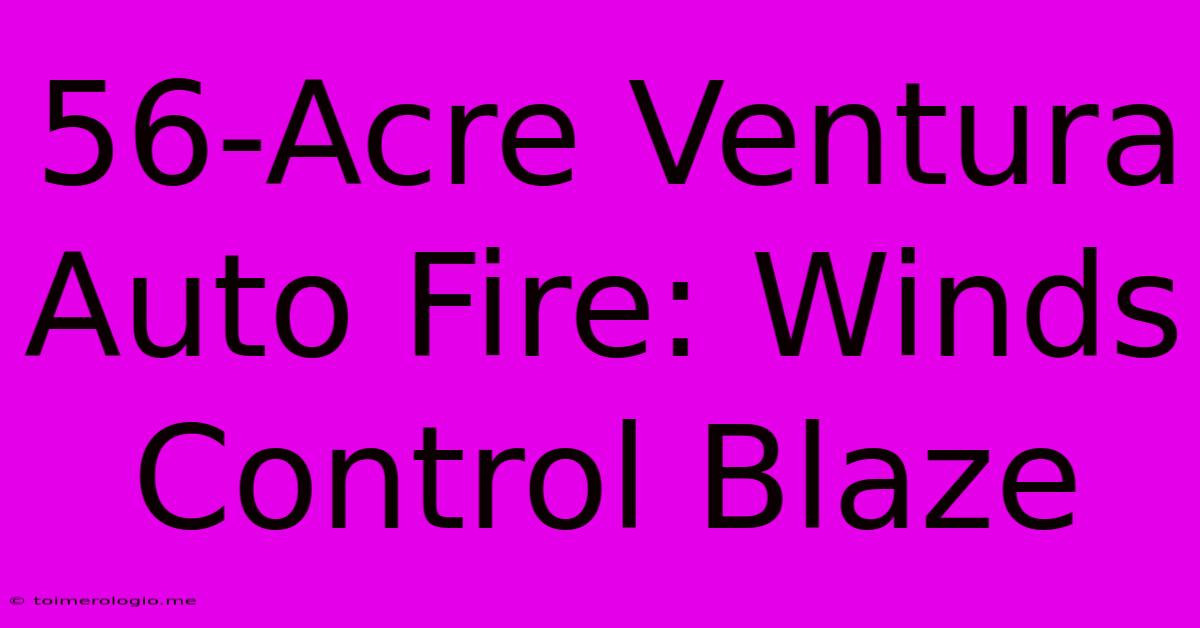56-Acre Ventura Auto Fire: Winds Control Blaze

Discover more detailed and exciting information on our website. Click the link below to start your adventure: Visit Best Website toimerologio.me. Don't miss out!
Table of Contents
56-Acre Ventura Auto Fire: Winds Control Blaze
The relentless California sun beat down on Ventura County on [Insert Date], igniting a fierce fire that quickly consumed 56 acres of land. This wasn't your typical brush fire; this blaze, originating near an auto salvage yard, was fueled by dry vegetation and ferociously driven by unpredictable winds. The incident serves as a stark reminder of the volatile interplay between weather, geography, and human activity in wildfire scenarios. This article delves into the details of the Ventura auto fire, exploring the contributing factors, the heroic firefighting efforts, and the lasting impact on the community.
The Genesis of the Inferno: A Perfect Storm
The fire's origin, traced back to an auto salvage yard, immediately raises questions about potential ignition sources. While the exact cause remains under investigation, several factors could have contributed to the blaze's rapid escalation. These include:
- Dry Vegetation: California's notoriously dry climate, particularly during [mention specific season/month], creates a tinderbox of easily combustible materials. The dense, dry vegetation surrounding the auto salvage yard likely acted as a rapid fuel source for the expanding flames.
- Strong Winds: The Santa Ana winds, infamous for their unpredictable nature and high speeds, played a critical role in the fire's spread. These winds, often funneling down from the mountains, create intense downdrafts that can rapidly accelerate a fire's progression, making containment efforts significantly more challenging. Eyewitness accounts and fire department reports emphasize the wind's role in pushing the flames across the landscape.
- Potential Ignition Sources: Auto salvage yards contain numerous potential ignition sources, including discarded batteries, flammable fluids, and even the friction generated by metal-on-metal contact. A discarded cigarette, a malfunctioning electrical component, or even a spark from a vehicle repair could have easily ignited the dry vegetation.
Fighting the Fury: A Concerted Effort
The Ventura County Fire Department (VCFD), along with numerous supporting agencies, launched a swift and coordinated response. The scale of the operation was substantial, involving:
- Air Support: Water-dropping helicopters and air tankers played a crucial role in slowing the fire's advance. These aerial assets proved invaluable in targeting hard-to-reach areas and providing a strategic advantage against the wind-driven flames.
- Ground Crews: Firefighters on the ground battled the blaze using a combination of techniques, including controlled burns to create firebreaks and direct attack methods to extinguish the flames. Their bravery and tireless work were essential in containing the fire's spread.
- Community Collaboration: The fire's proximity to residential areas necessitated a high level of community engagement. Evacuation orders were issued for nearby residents, ensuring their safety and minimizing potential casualties. The smooth execution of evacuation plans speaks to the effective coordination between the fire department and local authorities.
The Aftermath: Scars and Lessons Learned
While the 56-acre blaze was ultimately contained, its impact lingers. The charred landscape serves as a poignant reminder of the destructive power of wildfires. The aftermath includes:
- Environmental Damage: The fire's impact on local flora and fauna is significant. The loss of vegetation disrupts the delicate ecosystem, impacting wildlife habitats and potentially leading to erosion. Reforestation efforts will be crucial in restoring the affected area.
- Property Damage: Although no structures were directly destroyed in this particular incident, the proximity of the fire to residential areas caused significant anxiety and disruption. The fear of losing homes and property underscores the critical importance of preventative measures.
- Economic Impact: The firefighting operation itself is a costly endeavor, requiring substantial resources and personnel. The potential for further economic disruption due to lost productivity and environmental damage cannot be overlooked.
Prevention and Preparedness: A Community Responsibility
The Ventura auto fire emphasizes the vital importance of wildfire prevention and preparedness. Several steps can be taken to mitigate future risks:
- Vegetation Management: Regular clearing of dry brush and vegetation around homes and businesses is crucial in reducing the risk of wildfire spread. Implementing responsible land management practices is paramount.
- Public Awareness: Education and public awareness campaigns can significantly contribute to preventing wildfires. Promoting safe practices regarding fire use, discarding cigarettes responsibly, and maintaining proper equipment are all crucial.
- Early Warning Systems: Robust early warning systems, including advanced weather forecasting and improved communication networks, are essential for providing timely alerts and facilitating rapid evacuations.
The Ventura auto fire, while contained, serves as a harsh reminder of the potential dangers associated with wildfires in California. The combination of dry vegetation, strong winds, and potential ignition sources created a dangerous situation, showcasing the delicate balance between human activity and the natural environment. The heroic efforts of firefighters, coupled with community preparedness, averted a potentially much larger disaster. However, this event underscores the need for ongoing vigilance and proactive measures to minimize future risks. Continued investment in wildfire prevention, improved early warning systems, and community education are crucial in safeguarding Ventura County and other fire-prone regions. Only through collective responsibility and preparedness can we hope to minimize the devastating impacts of future wildfires.

Thank you for visiting our website wich cover about 56-Acre Ventura Auto Fire: Winds Control Blaze. We hope the information provided has been useful to you. Feel free to contact us if you have any questions or need further assistance. See you next time and dont miss to bookmark.
Also read the following articles
| Article Title | Date |
|---|---|
| Jessica Simpsons 10 Year Marriage To Eric Johnson | Jan 16, 2025 |
| Warriors Star Curry Under Fire Support Drops | Jan 16, 2025 |
| Steph Curry Loses Fan Support Amidst Scandal | Jan 16, 2025 |
| Criticism Mounts Against Steph Curry Warriors | Jan 16, 2025 |
| Curry Faces Backlash Warriors Support Wanes | Jan 16, 2025 |
